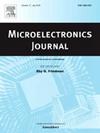5-GSPS连续时间ΔΣ调制器,嵌套前馈补偿OTA和电阻接地电流转向DAC,实现225-MHz带宽和68.5 db信噪比
IF 1.9
3区 工程技术
Q3 ENGINEERING, ELECTRICAL & ELECTRONIC
引用次数: 0
摘要
本文提出了一种用于宽带通信的28纳米CMOS工艺的5-GSPS三阶连续时间(CT) ΔΣ调制器,其中提出了具有嵌套前馈补偿(NFC)和电阻接地电流导向DAC的操作跨导放大器(ota),以解决非线性和热噪声的挑战。该调制器采用单回路级联谐振器反馈(CRFB)拓扑结构设计,以避免多级架构中的信号/噪声泄漏问题,同时结合参考变换和自定时电容电压DAC来补偿多余的环路延迟(ELD),并具有对工艺、电压和温度(PVT)变化的抗扰性。在主反馈路径中采用了电阻接地的电流转向DAC,与传统的基于晶体管的接地方案相比,可以降低约30%的热噪声。集成器中带有NFC的OTA采用负跨导和和和电容来增强带内增益,而集成器也采用基于R-2R的可编程电阻结构来实现输入阻抗几乎恒定的系统系数可重构。仿真结果表明,CT ΔΣ调制器的布局面积为0.35 mm2,在225-MHz带宽下实现了68.5 db的信噪比(SNR)、76.6 db的无杂散动态范围(SFDR)和11.1 bit的有效位数(ENOB),功耗为112 mw, Schreier性能图(FoMs)为162.1 db。本文章由计算机程序翻译,如有差异,请以英文原文为准。
A 5-GSPS continuous-time ΔΣ modulator with nested feedforward compensation OTA and resistive−grounded current-steering DAC achieving 225-MHz bandwidth and 68.5-dB SNR
This paper presents a 5-GSPS, 3rd-order continuous-time (CT) ΔΣ modulator in 28-nm CMOS process for wideband communications, in which operational transconductance amplifiers (OTAs) with nested feedforward compensation (NFC) and resistive-grounded current-steering DAC are proposed to address challenges of nonlinearity and thermal noise. The modulator is designed with a single-loop cascade resonator feedback (CRFB) topology to avoid signal/noise leakage issues in multistage architectures, while reference shuffling and self-timed capacitor-voltage DAC are combined to compensate the excess loop delay (ELD) with immunity to process, voltage and temperature (PVT) variations. A resistive-grounded current-steering DAC is employed in the main feedback path, which reduces thermal noise by about 30 % compared to conventional transistor-based grounding scheme. The OTA with NFC in the integrator adopts negative transconductance with neutralization capacitors to enhance the in-band gain, while an R-2R based programmable resistor structure is also employed for the integrator to realize reconfigurable system coefficients with almost constant input impedance. With a layout area of 0.35 mm2, simulation results demonstrate that the CT ΔΣ modulator achieves a 68.5-dB signal-to-noise ratio (SNR), a 76.6-dB spurious-free dynamic range (SFDR), and an 11.1-bit effective number of bits (ENOB) in 225-MHz bandwidth, with 112-mW power consumption and Schreier figure-of-merit (FoMs) of 162.1-dB.
求助全文
通过发布文献求助,成功后即可免费获取论文全文。
去求助
来源期刊

Microelectronics Journal
工程技术-工程:电子与电气
CiteScore
4.00
自引率
27.30%
发文量
222
审稿时长
43 days
期刊介绍:
Published since 1969, the Microelectronics Journal is an international forum for the dissemination of research and applications of microelectronic systems, circuits, and emerging technologies. Papers published in the Microelectronics Journal have undergone peer review to ensure originality, relevance, and timeliness. The journal thus provides a worldwide, regular, and comprehensive update on microelectronic circuits and systems.
The Microelectronics Journal invites papers describing significant research and applications in all of the areas listed below. Comprehensive review/survey papers covering recent developments will also be considered. The Microelectronics Journal covers circuits and systems. This topic includes but is not limited to: Analog, digital, mixed, and RF circuits and related design methodologies; Logic, architectural, and system level synthesis; Testing, design for testability, built-in self-test; Area, power, and thermal analysis and design; Mixed-domain simulation and design; Embedded systems; Non-von Neumann computing and related technologies and circuits; Design and test of high complexity systems integration; SoC, NoC, SIP, and NIP design and test; 3-D integration design and analysis; Emerging device technologies and circuits, such as FinFETs, SETs, spintronics, SFQ, MTJ, etc.
Application aspects such as signal and image processing including circuits for cryptography, sensors, and actuators including sensor networks, reliability and quality issues, and economic models are also welcome.
 求助内容:
求助内容: 应助结果提醒方式:
应助结果提醒方式:


